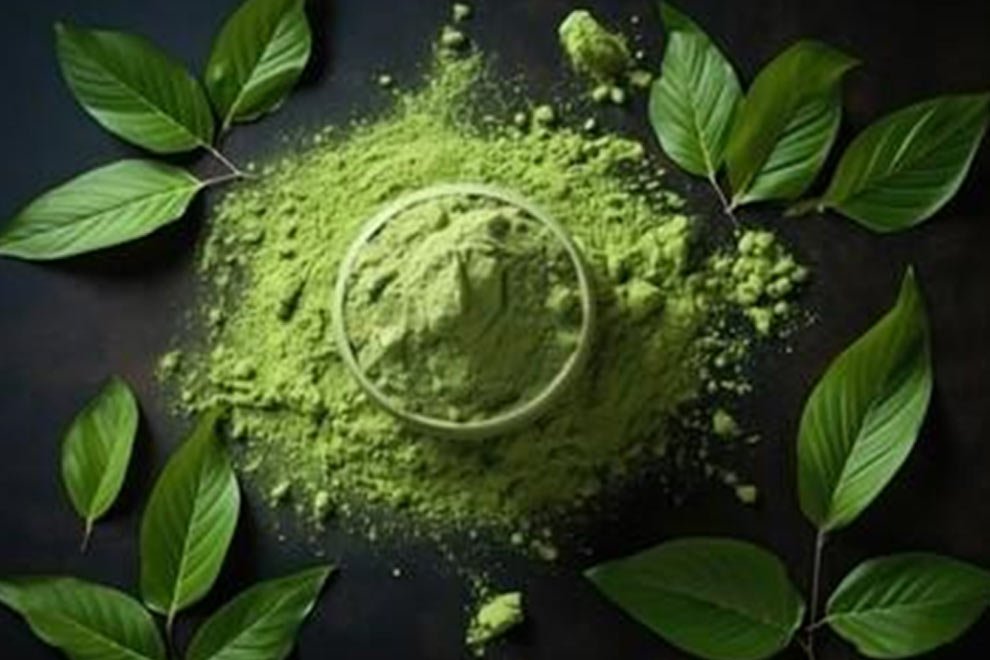White Borneo is traditionally associated with energetic properties. However, this strain can produce a broad spectrum of effects, depending on the doses consumed.
Read below for a comprehensive guide to white Borneo. Some of the areas the post shall cover include white Borneo’s origin, benefits, adverse effects, and dosage guidelines.
What Is White Borneo?
You’ve probably stumbled upon the terms “white Borneo,” “red Malay,” or “Green Bali” while searching for kratom supplements. These words denote the dominant strains in a kratom product.
White Borneo kratom is a white-vein kratom cultivar indigenous to Borneo Island.
Note that much of the kratom consumed worldwide comes from Southeast Asia. However, the tree occurs in multiple strains, and each cultivar thrives in specific regions within the vast Southeast Asia.
Besides tracing its roots to Borneo Island, white Borneo also stands out for the distinct whitish pigmentation of its leaf veins.
White is one of the three major colors that kratom leaf veins come in, the other two being red and green. These color distinctions aren’t just for show. They’re crucial in assigning strains their respective names and, by extension, determining the dominant effects of each cultivar.
What Makes White Borneo Special?
White-vein kratom strains are widespread throughout most of Southeast Asia. There’s white Bali from Bali Island, White Malay from Malaysia, white Maeng Da from Thailand, et cetera.
So, what makes white Borneo special?
Much of Southeast Asia has a tropical climate. The region receives significant rainfall and sunshine all year round, making it an excellent habitat for kratom. However, Borneo provides specific conditions required to develop the active alkaloids in kratom.
Besides registering high rainfall of 2,000 – 4,000mm each year, Borneo’s annual temperatures range from 80 – 90 F (27 – 32 C) while relative humidity staggers around 80%. These are the very conditions kratom requires to flourish.
Borneo’s warm temperature, high humidity, and extended sunshine are particularly important in developing alkaloid-rich kratom strains like white Borneo.

What Are The Benefits Of White Borneo?
Many kratom users consume white Borneo for its energizing properties.
Note that kratom belongs in the same family as coffee. That explains why extracts from both plants are generally stimulating.
White Borneo uplifts your spirits by binding to opioid receptors in the brain. The two most bioactive alkaloids in the plant – mitragynine converts to 7-hydroxymitragynine – bind to all major opioid receptors, including mu, delta, and kappa receptors. Those interactions produce a host of pharmacological effects, including relief from fatigue.
Below are other potential effects of white Borneo kratom;
1. Elevating the Mood
White Borneo is stimulating at low-to-moderate doses but soothing at higher doses. The strain’s calming effects make it a potential remedy for a variety of mental health issues, such as mood swings.
If you think you’re having a bad day in the office, simply take a break from your workstation and administer measured doses of white Borneo. You’ll be surprised at how fast the strain will improve your mood.
2. Supporting Quality Sleep
Thanks to white Borneo’s soothing properties, the strain may improve the symptoms of sleep deprivation.
Consuming white Borneo late in the evening might help combat insomnia by shortening your sleep latency. This can be particularly useful when you’re trying to repay sleep debt.
3. Alleviating Body Aches
Many white Borneo users also report relief from body aches. The strain’s analgesic properties are largely due to its interactions with opioid receptors.
When consumed, the alkaloids in white Borneo bind to certain opioid receptors in a manner that desensitizes the brain’s interpretation of pain signals.
4. Combating Inflammation
Pain and inflammation are intertwined. So, it’s unsurprising that white Borneo might help to remedy both ailments.
A 2017 review of existing studies found that kratom extracts possess anti-inflammatory, appetite-suppressing, and immune-boosting properties.
Like most kratom strains, white Borneo fights inflammation by inhibiting cytokine and chemokine production.

Will White Borneo Get Me High?
Kratom, particularly white-vein species, possesses certain mind-altering properties. Consuming white Borneo might trigger a mild rush of euphoria.
However, kratom’s ‘high’ is milder and more tolerable compared to renowned psychedelic compounds like tetrahydrocannabinol (THC). Most users report enhanced mood, alertness, and sociability.
These are the same effects triggered by conventional opiates. The difference is that white Borneo is easier on the psyche than regular opioid drugs.
Should I Expect Adverse Effects?
Kratom is safer than most herbs. Even stimulating strains like white Borneo are unlikely to trigger worrying adverse effects if you stick to the recommended dosages.
Many healthcare experts cite 1 – 5 grams of white Borneo as the standard daily energizing dosage. If you increase the serving amounts to 5 – 15 grams/day, the strain becomes more soothing than uplifting. Anything higher than 15 grams/day might trigger a series of unpleasant effects.
The severity of white Borneo kratom’s side effects depends on individual tolerance and sensitivity to the plant.
Some users will only report mild and short-lasting gastrointestinal problems, such as vomiting and diarrhea. Others may experience more dramatic reactions to the plant, including drowsiness and irritability.
Lowering your doses and taking a break is the surest way to minimize any side effects to white Borneo.

Wrap Up
White Borneo is a broad-spectrum kratom strain whose effects vary depending on the doses administered. Therefore, it’s best to define your needs before using white Borneo supplements.
Remember that, like most kratom cultivars, white Borneo is most effective at moderate doses. Administering the strain sparingly is critical to unlocking its perceived therapeutic benefits.
Also Read: Red Borneo Kratom: 5 Ways It Can Improve Your Mental Health










